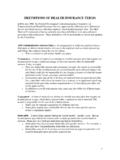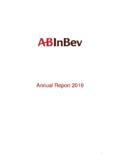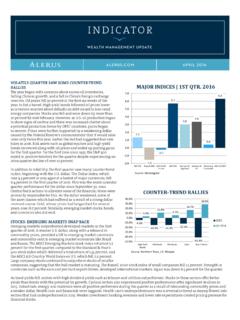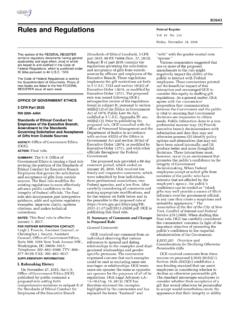Transcription of Persons with a Disability: Labor Force Characteristics …
1 For release 10:00 (EDT) Wednesday, June 21, 2017 USDL-17-0857 Technical information: (202) 691-6378 Media contact: (202) 691-5902 Persons WITH A DISABILITY: Labor Force Characteristics 2016 In 2016 , percent of Persons with a disability were employed, the Bureau of Labor Statistics reported today. In contrast, the employment-population ratio for those without a disability was percent. The employment-population ratio for both Persons with and without a disability increased from 2015 to 2016 (by percentage point for Persons with a disability and by percentage point for Persons with no disability). The unemployment rate for Persons with a disability, at percent, was little changed from the previous year, while the rate for those without a disability declined to percent. The data on Persons with a disability are collected as part of the Current Population Survey (CPS), a monthly sample survey of about 60,000 households that provides statistics on employment and unemployment in the United States.
2 The collection of data on Persons with a disability is sponsored by the Department of Labor s Office of Disability Employment Policy. For more information, see the Technical Note in this news release. Highlights from the 2016 data: Nearly half of all Persons with a disability were age 65 and over, about three times larger than the share of those with no disability. (See table 1.) For all age groups, the employment-population ratio was much lower for Persons with a disability than for those with no disability. (See table 1.) For all educational attainment groups, jobless rates for Persons with a disability were higher than those for Persons without a disability. (See table 1.) In 2016 , 34 percent of workers with a disability were employed part time, compared with 18 percent for those with no disability. (See table 2.) Employed Persons with a disability were more likely to be self-employed than those with no disability.
3 (See table 4.) -2- Demographic Characteristics Persons with a disability tend to be older than Persons with no disability, reflecting the increased incidence of disability with age. In 2016 , 47 percent of Persons with a disability were age 65 and over, compared with 15 percent of those with no disability. Women were more likely to have a disability than men, and Blacks and Whites had a higher prevalence of disability than Asians and Hispanics. (See table 1.) Employment In 2016 , the employment-population ratio for Persons with a disability increased from percent to percent. For those with no disability, the ratio increased from percent to percent. The lower ratio among Persons with a disability reflects, in part, the older age profile of Persons with a disability; older workers are less likely to be employed regardless of disability status. However, across all age groups, Persons with a disability were much less likely to be employed than those with no disability.
4 (See tables A and 1.) Among Persons age 16 to 64, the employment-population ratio rose for both Persons with a disability ( percent) and those without a disability ( percent) from 2015 to 2016 . The ratio for Persons age 65 and over with a disability, at percent, increased in 2016 , while the ratio for Persons without a disability, at percent, changed little. (See table A.) Persons with a disability are less likely to have completed a bachelor s degree or higher than those with no disability. Among both groups, those who had attained higher levels of education were more likely to be employed than those with less education. Across all levels of education in 2016 , Persons with a disability were much less likely to be employed than were their counterparts with no disability. (Educational attainment data are presented for those age 25 and over.) (See table 1.) Workers with a disability were more likely to be employed part time than those with no disability.
5 Among workers with a disability, 34 percent usually worked part time in 2016 , compared with 18 percent of those without a disability. The proportion of workers who were employed part time for economic reasons continued to be slightly higher among those with a disability than among those without a disability (6 percent versus 4 percent). These individuals were working part time because their hours had been cut back or because they were not able to find a full-time job. (See table 2.) In 2016 , Persons with a disability were more concentrated in service occupations than those with no disability ( percent, compared with percent). Workers with a disability were more likely than those with no disability to work in production, transportation, and material moving occupations ( percent, compared with percent). Persons with a disability were less likely to work in management, professional, and related occupations than those without a disability ( percent, compared with percent).
6 (See table 3.) The proportion of Persons employed in government was about the same for both Persons with a disability and Persons without a disability in 2016 ( percent and percent, respectively). However, a smaller share of workers with a disability were employed as private wage and salary workers ( percent), compared with those with no disability ( percent), and a larger share were self-employed than were those with no disability ( percent versus percent). (See table 4.) -3-Unemployment The unemployment rate for Persons with a disability was percent in 2016 , about twice that of those with no disability ( percent). (Unemployed Persons are those who did not have a job, were available for work, and were actively looking for a job in the 4 weeks preceding the survey.) The unemployment rate for Persons with a disability was little changed over the year, while the rate for Persons without a disability declined by percentage point to percent in 2016 .
7 (See tables A and 1.) Among Persons with a disability, the unemployment rates were similar for both men and women in 2016 ( percent and percent, respectively). The rates for both men and women changed little from 2015 to 2016 . Jobless rates for Persons with a disability also showed little change among major race and ethnicity groups in 2016 . As is the case among Persons without a disability, the jobless rate for those with a disability was higher for Blacks ( percent) than for Hispanics ( percent), Asians ( percent), and Whites ( percent). (See table 1.) Not in the Labor Force Persons who are neither employed nor unemployed are not in the Labor Force . A larger proportion of Persons with a disability about 8 in 10 were not in the Labor Force in 2016 , compared with about 3 in 10 of those with no disability. In part, this reflects the older age profile of Persons with a disability; Persons age 65 and over are much less likely to participate in the Labor Force than younger age groups.
8 Across all age groups, however, Persons with a disability were more likely to be out of the Labor Force than those with no disability. (See table 1.) Regardless of disability status, the vast majority of those not in the Labor Force do not want a job; in 2016 , 3 percent of those with a disability and 7 percent of those without a disability wanted a job. About 1 percent of Persons with a disability and 2 percent of those without a disability were marginally attached to the Labor Force . These individuals wanted and were available to work, and had looked for a job sometime in the prior 12 months. They were not counted as unemployed because they had not searched for work in the 4 weeks preceding the survey. ( Persons marginally attached to the Labor Force include discouraged workers.) (See table 5.) Table A. Employment status of the civilian noninstitutional population by disability status and age, 2015 and2016 annual averages[Numbers in thousands]Characteristic20152016 Total, 16yearsandover16 to 64years65 yearsand overTotal, 16yearsand over16 to 64years65 yearsand overPERSONS WITH A DISABILITYC ivilian noninstitutional ,75215,77113,98129,97115,74614,225 Civilian Labor ,8134,8121,0016,0054,9191,086 Participation ,1934,2509425,3724,3561,016 Employment-population in Labor ,93910,95912,98023,96510,82713,139 Persons WITH NO DISABILITYC ivilian noninstitutional ,049188,52132,528223,567189,75733,810 Civilian Labor ,317143,5177,800153,182144,9968,185 Participation ,641136,1197,522146,064138,1647,900 Employment-population ,6767,3982787,1186,832285 Unemployment in Labor ,73245,00424,72870,38544,76125,624 NOTE.
9 Updated population controls are introduced annually with the release of January Note The estimates in this release are based on annual average data obtained from the Current Population Survey (CPS). The CPS, which is conducted by the Census Bureau for the Bureau of Labor Statistics (BLS), is a monthly survey of about 60,000 eligible households that provides information on the Labor Force status, demographics, and other Characteristics of the nation's civilian noninstitutional population age 16 and over. Questions were added to the CPS in June 2008 to identify Persons with a disability in the civilian noninstitutional population age 16 and older. The addition of these questions allowed the BLS to begin releasing monthly Labor Force data from the CPS for Persons with a disability. The collection of these data is sponsored by the Department of Labor 's Office of Disability Employment Policy.
10 Information in this release will be made available to sensory-impaired individuals upon request. Voice phone: (202) 691-5200; Federal Relay Service: (800) 877-8339. Reliability of the estimates Statistics based on the CPS are subject to both sampling and nonsampling error. When a sample, rather than the entire population, is surveyed, there is a chance that the sample estimates may differ from the true population values they represent. The component of this difference that occurs because samples differ by chance is known as sampling error, and its variability is measured by the standard error of the estimate. There is about a 90-percent chance, or level of confidence, that an estimate based on a sample will differ by no more than standard errors from the true population value because of sampling error. BLS analyses are generally conducted at the 90-percent level of confidence.
















![N=ifr 'kkgw th egkjkt fo'ofo|ky;] dkuiqjN=ifr 'kkgw …](/cache/preview/e/7/2/8/e/5/e/f/thumb-e728e5ef72642c219bc520d9a94f4cec.jpg)